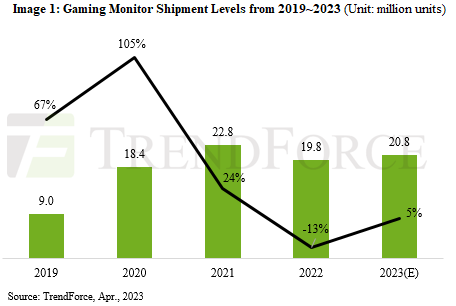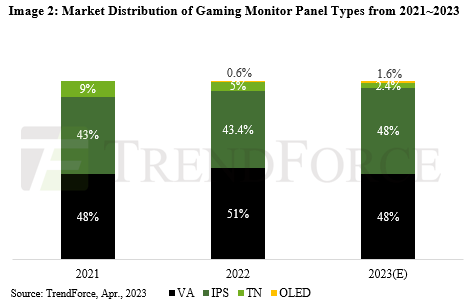
Last year, gaming monitor shipments declined for the first time since 2016, according to research from TrendForce. The analysis firm suggests that "high inflation" led to 19.8 million gaming monitors being shipped last year, a 13% decline year-over-year. But the same research indicates that the rebound may be swift, with 20.8 million units shipping this year (a 5% year-over-year increase). According to TrendForce, VA monitors made up the majority of the gaming monitor market last year, coming in at 51%. IPS displays followed at 43.4%, and TV screens at 5%. OLED monitors, while becoming increasingly more popular, made up 0.6% of shipments in 2022.

Of those monitors, screens with 165 - 180 Hz refresh rates led the market at 51.9%, with 120 - 160 Hz screens at 32.5%, 100 Hz at 3.9% and 200 Hz and faster at 11.7%.
The potential rebound, the analysts believe, has three components. Firstly, several brands are taking their slowest 75 Hz panels and bumping them up to 100 Hz, marking a reason for budget monitor owners to upgrade. Additionally, China lifting Covid restrictions could mean Internet cafes will see reasons to buy more displays. Lastly, the 2023 Hangzhou Asian Games will add esports as a competing category, which might drive sales of displays for aspiring competitors.

TrendForce estimates that in 2023, OLED monitors will see a significant bump to 1.6% of the market due to "the diversification of... products" and that IPS monitors will be more competitive with VA screens due to price drops. It also expects that 100 Hz monitors will "mostly replace" 75 Hz monitors on the low-end, while the share of 120 - 160 Hz monitors will be brought into 165 - 180 Hz panels, as they already see little price difference.
In our guide to the best gaming monitors, we suggest that OLED is the best for image quality (but more expensive), followed by VA monitors with excellent contrast, then IPS displays with slightly slower response times but better color than VA. TN are the cheapest and often the fastest, but with poor viewing angles. For refresh rates, the fastest you can get is typically the best, especially for esports. But, of course, these predictions are strictly for gaming monitors, not your typical office or productivity monitor. So we'll see if 100 Hz panels at the low-end roll over to non-gaming screens in the future.







